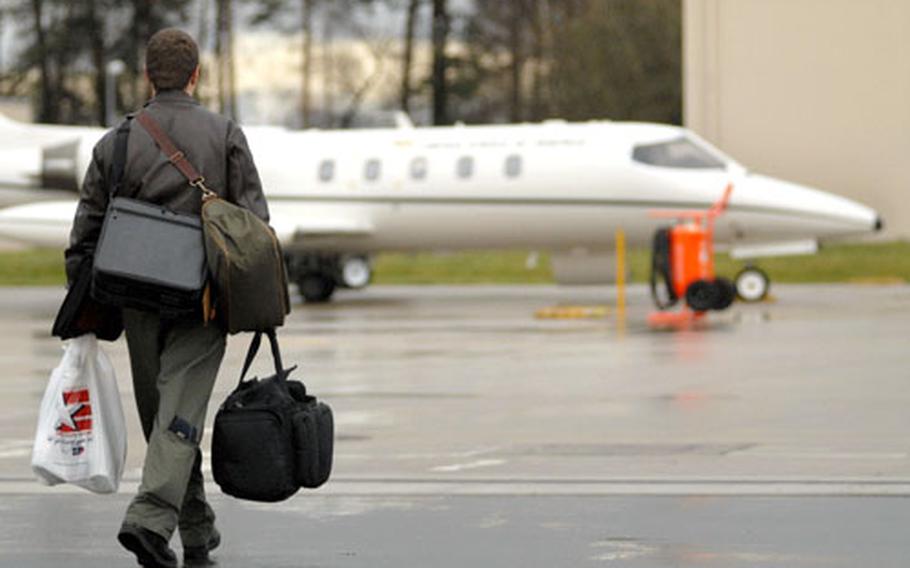
Capt. Matt Dudderar, a pilot assigned to the 76th Airlift Squadron, walks to a C-21 bound for the Aerospace Maintenance and Regeneration Center at Davis-Monthan Air Force Base, Ariz., on Monday. (Ben Bloker / Stars and Stripes)
KAISERSLAUTERN, Germany — Air Force squadrons at bases worldwide — including Ramstein Air Base — have begun retiring more than half of their C-21 fleet as part of a servicewide effort to cut personnel and save money.
The Air Force announced last month that it will transfer 38 aircraft, sending 16 from active-duty units to the Air National Guard in Fargo, N.D., and Bradley, Conn. The rest of the jets will be sent to the Aerospace Maintenance and Regeneration Center at Davis-Monthan Air Force Base, Ariz., and the Air Force Flight Standards Agency at Will Rogers Air Guard Station in Oklahoma City, Okla.
The C-21 is the military’s version of the Lear 35A business jet and is used mostly to transport senior-level officials, cargo and ambulatory patients. The twin turbofan engine aircraft, which first arrived in the Air Force in 1984, carries seven passengers.
The Air Force’s active-duty fleet had 74 C-21As, according to the service’s Web site. Each cost more than $3 million in 1996.
Ramstein’s 76th Airlift Squadron will lose three of its 13 C-21s, commander Lt. Col. Dan Baldessari said. He flew the first C-21 from the squadron’s fleet on Monday afternoon to Davis-Monthan. The others will leave Ramstein later this month.
“We are fortunate to be losing only three,” Baldessari said. “There are units in the States who have lost half or more of their C-21s — or are going to — based on these budget decisions.”
The secretary of the Air Force approved the retirement of the planes as part of the service’s plans to slash 40,000 positions from its ranks to buy new planes and modernize the force.
Trimming the C-21As from the active-duty inventory will affect 91 positions at Ramstein; Keesler Air Force Base, Miss.; Wright- Patterson Air Force Base, Ohio; Scott Air Force Base, Ill.; Andrews Air Force Base, Md.; Peterson Air Force Base, Colo.; and Yokota Air Base, Japan.
The 76th will lose 17 of its 40 pilot positions through attrition, Baldessari said. But the unit does not expect to see a drop in the number of passengers.
The squadron ferries senior officers around the U.S. European Command’s area of operations — which includes Europe and most of Africa.
Last year, the Ramstein unit was busy, flying nearly 3,000 missions. That’s 1,000 more than the previous year, Baldessari said. The unit flew more than 120 aeromedical evacuations.
The loss of the aircraft will not affect the ambulatory missions, Baldessari said. Crews will continue to be on alert around the clock to transport patients who need urgent care. However, the unit plans to combine missions for senior officers, Baldessari said. When possible, passengers would have to take flights together.
Baldessari said he doesn’t expect to fly as many as missions in 2007.
“But it’s not out of the realm of possibility depending on how heavy the tasking is consistently,” he said.
“... (We) know we’re going to accomplish the vast majority of the missions even though we lost three airplanes,” he added.